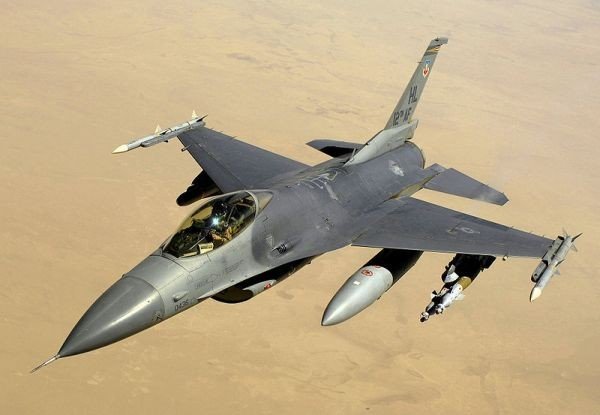BAGHDAD, Dec. 6 (UPI) -- Iraq wants to make a deal with the United States for another 18 Lockheed Martin F-16 multi-role fighters to expand its fledgling air force as the U.S. military withdrawal nears completion.
But Iraq still has a long way to go before it can have even the most rudimentary air-defense capabilities. Right now, even neighboring Iran's badly rundown air force could pulverize Iraq if Tehran wanted to.
Baghdad ordered 18 F-16 Block 52 jets and assorted weapons systems, total value around $4.5 billion, in September. The F-16IQ aircraft, enough for one squadron, were the new Iraqi air force's first combat jets.
They will have advanced electronic systems, including the APG-68v9 radars, the most modern available to Block 50 aircraft, and countermeasures systems. They will be armed with Raytheon's AIM-120 advanced medium-range air-to-air missiles, which can be fired beyond visual range.
Iraq's air force was once one of the most powerful in the Arab world under Saddam Hussein. At the end of the 1980-88 war with Iran, it had 500 combat aircraft, including Soviet-built Tupolev Tu-22 and Tu-16 bombers.
But it was essentially wiped out by U.S. and coalition forces in the 1991 war over Kuwait. It was grounded throughout the U.S. invasion in 2003.
The U.S.-approved plan to rebuild a self-sufficient air force from the ashes of defeat envisions a strength of 350 aircraft and 20,000 personnel by 2020.
Eighteen F-16s aircraft, or even 36, will be far too few to effectively cover Iraq, an area of 169,234 square miles.
"So looking at Iraq's position in the region, having those planes is not much," Ali Musawi, a close aide of Prime Minister Nouri al-Maliki, observed recently. "But it is a beginning."
Iraqi officials have talked of building a force of 96 F-16s, enough for five squadrons, using windfall profits from oil exports to bankroll the acquisitions. But no final figure has been announced.
Even so, that's all as much as a decade away from fruition as it takes years to build up a fully operational air force, train air and ground crews and install a nationwide radar and air-defense network with guns and missiles.
Given that many Iraqis don't want any residual U.S. combat forces left in the country after the Dec. 31 withdrawal deadline, Maliki seems to be in a hurry to build up his military forces as quickly as possible.
Right now, the air force has no firepower at all. The first batch of Iraqi fighter pilots is training at the Iraqi Air Force Academy at Tikrit Air Base, north of Baghdad, which opened in 2010.
The Iraqi air force commander, Lt. Gen. Anwar Amin, has said he also wants to fast-track the procurement of intelligence, surveillance and reconnaissance aircraft, including unmanned aerial vehicles.
The Pentagon has indicated that possible sales to Iraq include a Lockheed Martin AN/FPS-117 phased array long-range air search radar, worth about $142 million, and at least one King Air 350 ER aircraft for ISR, worth around $900 million.
The air force has one ISR squadron with Seabird SB7 L-360 Seekers based at Basra in the south, and another with SB7L-360 Seekers and Cessna 208B Grand caravans at Kirkuk in the north.
"Iraq's air-defense radar and long-range radar systems will be fully functional by the middle of next year," The Iraq Daily Times reported recently.
The Iraqi military, it added, also "now has a modern air-operations center that controls military aircraft throughout the country and is able to sound a warning if the borders are breached."
Nasser al-Ani, the chief of staff of Iraqi President Jalal Talabani, was quoted as saying at a recent conference in Saudi Arabia that Baghdad was interested in seeking a joint air-defense agreement with Arab states in the Persian Gulf.
That's a novel way to secure Iraqi air space in the absence of a functioning air force.
It's not clear how far that suggestion has gone but relations between Shiite-dominated Iraq and the U.S.-backed Sunni monarchies of the gulf are strained, to say the least.
So it's difficult to envisage such an agreement emerging between the long-time adversaries. But if it's seen to curtail Iranian ambitions in Iraq it might find some traction.















